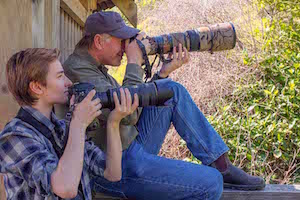 We were lying on our tummies on plastic bags in the damp bush, trying to hold our cameras steady while photographing some tiny mushroom shaped lichens. A group of dog walkers gave us a quizzical look as they passed by.
We were lying on our tummies on plastic bags in the damp bush, trying to hold our cameras steady while photographing some tiny mushroom shaped lichens. A group of dog walkers gave us a quizzical look as they passed by.
Our tutor Edin had created an ingenious lighting system with a small reflector and the torch on her iPhone. These lit up the lichens with a magical glow, creating the illusion of a miniature fairy forest.
Further down the track we clambered down a somewhat slippery slope holding onto tree trunks to where Tony (Edin’s father) had set up his tripod near a small waterfall. He demonstrated how a slow shutter speed can blur water creating a sense of movement and a fast one can capture the droplets clearly as they fall,
About twenty of us were at a weekend Nature Photography course at Kaipatiki (all ages and stages from a teenager to a few grey haired ones) all eager to learn how to make better use of our DSLR cameras.
Our tutors were Edin and Tony Whitehead, both award winning nature photographers and ardent conservationists. In 2014 Edin was the New Zealand Geographic’s Young Photographer of the year. They strive after perfection and beauty in their photographs but more important to them is as Edin has put it is
“To use my photographs to impart the wonder and curiosity I have for the natural world to others, and to convince others that conservation is essential to our continued existence.”
It turned out to be a full-on, but great weekend with our tutors giving us a thorough introduction to camera basics such as using our cameras on manual mode, understanding the relationship between aperture, ISO and shutter speed and composition.
We also learnt how to store our images safely and had a demonstration of post processing. Until then I had been under the impression that Photoshop and Lightroom, which are excellent for this, were very expensive and beyond my photography budget. They used to be but can now be accessed for a small monthly fee (about $10.00) which was good to know.
The best part was getting out into the bush and practising our camera skills. No matter that we finished up with very muddy shoes and wet socks.
So what do you do with all those photographs you so lovingly take? They soon mount up. Tony suggested we could allow conservation groups to use them for their publicity, turn them into gifts such as cards and photobooks or mount them in inexpensive frames and hang them around your house.
Tony and Edin have many precious memories of their photographic journeys both close to home and further afield to sub Antarctic islands, Africa and Antarctica. They love travelling together.
“Adventures are fun and feed the soul but shared adventures are a step beyond and feed the soul as well,” feels Tony.
Since attending this course I have loved reading about their adventures on their blogs.
On his blog http://www.tonywhitehead.com/wildlight/ Tony has recorded his experience of photographing on three of New Zealand’s remote Sub Antarctic Islands (Snares, Auckland Islands and Campbell Island) and included a selection of the amazing photos (he took 12000 images in all!)
The life of a wild life photographer has its moments! On his first day on Campbell Island , the wildest place he has ever visited, the wind was so severe that Tony had to lie down on the boardwalk to avoid being blown over, at which stage it began to hail on him.
The main attraction for him was the chance to see and photograph some new species of albatross and penguins but there were many other unexpected highlights.
What a unique opportunity to be able to photograph the inquisitive and playful sea lions, yearling elephant seals and yellow eyed penguins.
Edin has blogged about many of their journeys on her blog http://www.edinz.com/
In early February, 2015, she and her Dad travelled to the Antarctic Peninsula on board the National Geographic Explorer with Lindblad Expeditions.
Her photographs have brought this continent to life for me, its vast and icy landscape as well as the creatures which inhabit it including an Adelie penguin tobogganing , the happiest seal and a levitating chinstrap penguin.
At the end of this journey she had so fallen in love with Antarctica that, “I didn’t want to leave, so much so that I did briefly consider stowing away on the ship and trying to pass myself off as a naturalist/photographer (somewhat under-qualified, but I can learn on the job, right?).
I feel really privileged to have spent a weekend with these two generous and talented people.
It’s true that you can find a great deal of information on how to use your DSLR in your camera manual and from tutorials on the net. But spending a weekend with tutors who love photography, who were happy to give us some individual attention and to answer our questions was so much better. They really inspired us to move out of our comfort, zone and to head out into the bush to practice .And it was fun to do it in the company of a bunch of eager fellow learners. By the end of the weekend we were all full of enthusiasm and ready to follow our passion for photography. You never know where it might take us!
By Lyn Potter. Read more here.










Join the Discussion
Type out your comment here:
You must be logged in to post a comment.